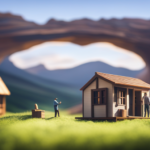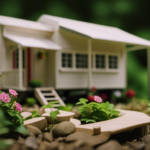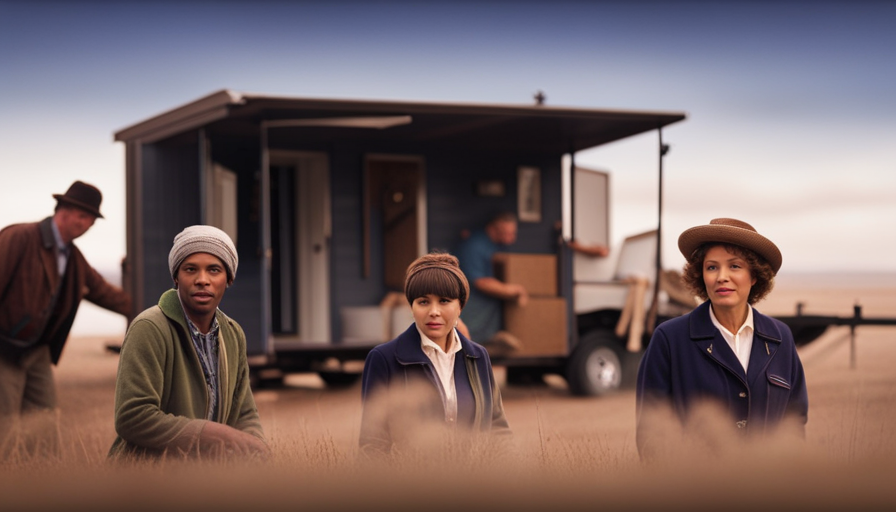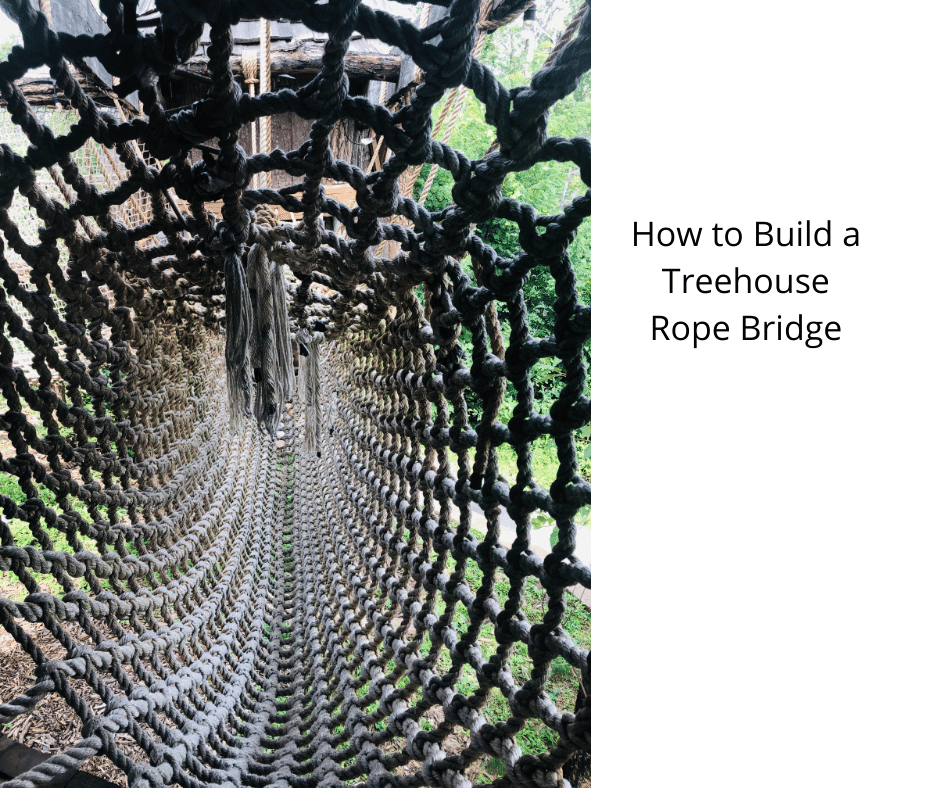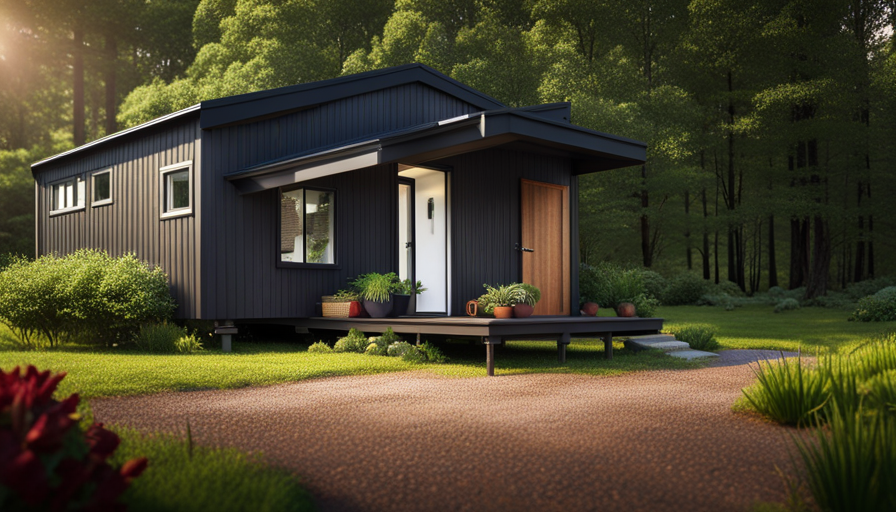Constructing your own small house can be a thrilling and fulfilling endeavor. Not only will it offer you a snug and customized living area, but it can also lead to substantial savings compared to purchasing a conventional home.
In this article, I will guide you through the process of building a tiny house from start to finish, highlighting the key steps and costs involved. From research and planning to gathering materials, construction, permits, and inspections, I will provide you with detailed information to help you make informed decisions.
Additionally, I will discuss the importance of interior design and furnishing, as well as considerations for land and foundation. Furthermore, I will address safety and security measures, as well as the ongoing maintenance and upkeep required for your tiny house.
By the end of this article, you will have a comprehensive understanding of the financial and practical aspects of building a tiny house yourself.
Key Takeaways
- Building a tiny house yourself can save money compared to buying a traditional home.
- Research and planning are crucial in the process of building a tiny house.
- Understanding local building codes and regulations is important to comply with them.
- Obtaining necessary permits and scheduling inspections are essential steps in the construction process.
Research and Planning
Thinking about building a tiny house yourself? Let’s dive into the research and planning stage! When it comes to building a tiny house, proper research techniques and budgeting strategies are crucial.
Before diving headfirst into construction, it’s important to gather all the necessary information and plan meticulously.
To start, researching different tiny house designs and layouts is essential. This can be done through online resources, books, or even visiting tiny house communities. By studying various designs, you can get a better understanding of what features and layouts work best for your specific needs.
Budgeting is another critical aspect of the research and planning stage. Setting a realistic budget will help you determine how much you can afford to spend on your tiny house project. Consider factors such as materials, tools, permits, and any professional assistance you might need.
Additionally, it’s vital to research and understand local building codes and regulations. Each area may have specific requirements for tiny houses, and it’s crucial to comply with these regulations to avoid any legal issues down the line.
As you wrap up the research and planning phase, it’s time to transition into gathering materials. This next step involves sourcing the necessary materials and creating a detailed list of everything you’ll need for construction.
Gathering Materials
When it comes to gathering materials, do you know where to find everything you need for your own little home? Sourcing materials is a crucial step in building a tiny house, and finding reliable suppliers can make the process smoother. Here are four key items to consider when it comes to gathering materials:
-
Lumber: Look for local lumberyards or online suppliers that offer a wide range of sustainably sourced lumber options. Consider factors such as quality, price, and delivery options when choosing a supplier.
-
Insulation: Research different types of insulation materials, such as spray foam or natural fibers, and find suppliers that offer competitive prices and good customer reviews. Some suppliers may even provide guidance on the best insulation options for a tiny house.
-
Windows and doors: Look for suppliers that specialize in energy-efficient windows and doors tailored for small spaces. Consider factors such as size, style, and price when selecting the right supplier.
-
Plumbing and electrical supplies: Find suppliers that offer a variety of plumbing and electrical materials suitable for small-scale installations. Look for suppliers that can provide guidance on the specific requirements for a tiny house.
By sourcing materials and finding reliable suppliers, you can ensure that your tiny house build goes smoothly. In the next section, we will delve into the construction process itself, discussing the various steps involved in bringing your tiny house to life.
Construction Process
Once you have gathered all the necessary materials, you can begin the construction process of bringing your own little home to life. The construction timeline for a tiny house can vary depending on the complexity of the design and your skill level. On average, it takes around 400 to 600 hours to build a tiny house from start to finish. This includes everything from laying the foundation to installing the roof.
When it comes to building techniques, there are several options to consider. One popular method is the stud framing technique, which involves constructing the walls using vertical studs and horizontal plates. This technique provides a sturdy and reliable structure for your tiny house.
Another technique is the SIPs (Structural Insulated Panels) method, which involves using pre-insulated panels for the walls and roof. This technique offers excellent insulation and can help reduce construction time.
In addition to these techniques, you will also need to consider other aspects of the construction process, such as electrical and plumbing installation, interior finishes, and exterior siding. These steps require careful planning and attention to detail to ensure everything is done properly.
Transitioning into the next section about the cost of labor, it’s important to note that while building a tiny house yourself can save you a significant amount of money, there are still costs associated with labor that need to be taken into account.
Cost of Labor
To really bring your dream home to life, you’ll need to consider the cost of labor involved in the construction process. The cost of labor can vary depending on a variety of factors, such as location, experience of the builders, and the complexity of the project. When calculating the cost of labor, it’s important to take into account the cost of materials as well. This includes everything from the framing and insulation to the plumbing and electrical work.
In addition to the cost of materials, you also need to consider the time commitment required to build a tiny house yourself. Building a tiny house is a labor-intensive process that requires a significant amount of time and effort. From designing the layout and sourcing materials to actually constructing the house, it can take several months or even longer to complete the project.
Despite the time and effort required, building a tiny house yourself can be a rewarding and cost-effective option. By taking on the labor yourself, you can save a significant amount of money compared to hiring a professional builder. However, it’s important to carefully consider the cost of labor and the time commitment before embarking on this project.
When it comes to building a tiny house, the cost of labor and the time commitment are just the beginning. The next step in the construction process involves obtaining permits and scheduling inspections to ensure that your tiny house meets all local building codes and regulations.
Permits and Inspections
Obtaining the necessary permits and scheduling inspections is a crucial step in ensuring that your dream home meets all local building codes and regulations. Before you start building your tiny house, it’s essential to research and understand the specific permits required in your area.
These permits may include building permits, electrical permits, plumbing permits, and zoning permits. Each jurisdiction has its own set of rules and regulations, so it’s important to contact your local building department to determine the exact requirements.
To obtain the necessary permits, you’ll typically need to submit detailed plans and specifications of your tiny house. These plans will be reviewed by the building department to ensure compliance with building codes and regulations. Once your plans are approved, you’ll receive the necessary permits to begin construction.
In addition to obtaining permits, scheduling inspections is another critical aspect of the building process. Inspections are conducted at various stages of construction to ensure that the work is being done according to the approved plans and meets all safety requirements. Inspections may include foundation inspections, framing inspections, electrical inspections, plumbing inspections, and final inspections.
By obtaining the required permits and scheduling inspections, you can ensure that your tiny house is built to code and meets all safety standards. This’ll help you avoid costly fines and penalties in the future.
Now, let’s move on to the next section about utilities and off-grid options.
Utilities and Off-Grid Options
When it comes to utilities and off-grid options, you’ll be amazed by the freedom and self-sufficiency you can achieve in your dream home. Off-grid living allows you to disconnect from traditional utilities and rely on renewable energy options. This not only reduces your environmental impact but also gives you the flexibility to live in remote locations without the need for a power grid or water supply.
One of the key aspects of off-grid living is the use of renewable energy sources. Solar panels, wind turbines, and hydroelectric systems can provide you with a reliable source of electricity. These systems can be integrated into your tiny house design, ensuring that you have a sustainable source of power. Additionally, rainwater harvesting systems and composting toilets can help you reduce your reliance on traditional water and sewage systems.
To highlight the benefits of off-grid living and renewable energy options, consider the following table:
| Benefit | Description | Example |
|---|---|---|
| Energy Independence | Generate your own power and reduce reliance on the grid | Solar panels on the roof |
| Environmental Impact | Reduce carbon footprint and promote sustainability | Wind turbine in the yard |
| Cost Savings | Lower utility bills and potential government incentives | Off-grid battery system |
With these off-grid options, you can create a sustainable and eco-friendly tiny house. In the next section about interior design and furnishing, we will explore how to make the most of your limited space.
Interior Design and Furnishing
Create a cozy and stylish living space by carefully selecting furniture and decor that maximize the limited space in your dream home. When it comes to interior design trends for tiny houses, minimalism is key. Opt for furniture pieces that serve multiple purposes, such as a sofa that can be transformed into a bed or a storage ottoman that can double as a coffee table. Look for compact and foldable furniture options to save space when not in use.
To further optimize the limited space, utilize vertical storage solutions such as tall bookshelves or wall-mounted cabinets. This will free up valuable floor space and keep your tiny house clutter-free. Additionally, choose light-colored paint for the walls to create an illusion of a larger space.
When it comes to decor, keep it simple and cohesive. Incorporate pops of color through throw pillows, rugs, or artwork to add personality to your tiny house. Natural elements such as plants can also bring life and freshness to the space.
Transitioning into the subsequent section about ‘land and foundation,’ it’s important to consider the location and foundation options for your tiny house to ensure stability and longevity.
Land and Foundation
When it comes to the land and foundation for my tiny house, there are a few key points I need to consider. First, I need to determine if I’ll rent or purchase the land. This decision will impact my long-term plans and financial commitments.
Second, I need to thoroughly research zoning and land use regulations to ensure that I’m allowed to build and live in a tiny house on the chosen land. This step is crucial to avoid any legal issues or setbacks.
Lastly, I need to explore different foundation options, such as a concrete slab or a trailer, to find the most suitable and cost-effective option for my tiny house.
Making the right choices in these areas will set the foundation for a successful and enjoyable tiny house living experience.
Determine if You Will Rent or Purchase Land
Deciding whether to rent or buy land for your tiny house is like choosing between a cozy cabin nestled in the woods or a beach bungalow with ocean views.
When it comes to rental options, you have the flexibility to move your tiny house to different locations, exploring various environments and communities. Renting land also allows you to test the waters and determine if living in a tiny house is the right fit for you before committing to a permanent location.
On the other hand, purchasing land offers stability and the freedom to customize your space according to your preferences. It provides a sense of ownership and the opportunity to establish roots in a specific area.
Researching zoning and land use regulations will be the next crucial step in your tiny house journey, ensuring that you find a suitable location for your dream home.
Research Zoning and Land Use Regulations
To truly ensure a smooth transition into your ideal living situation, it’s imperative that you conduct thorough research on zoning and land use regulations.
Zoning challenges and legal restrictions can have a significant impact on your ability to build a tiny house and live in it long-term. Different areas have different zoning requirements, which may include minimum square footage, setback requirements, and even restrictions on tiny houses altogether.
By researching these regulations, you can determine if the land you are considering is suitable for your tiny house plans. Additionally, you’ll also gain insight into any potential roadblocks or challenges you may face during the building process.
Understanding and complying with zoning and land use regulations will help you avoid unnecessary legal issues and ensure that your tiny house project is a success.
Now, let’s explore different foundation options.
Explore Different Foundation Options
After researching zoning and land use regulations for building a tiny house, I was excited to move on to exploring different foundation options. Choosing the right foundation is crucial for stability and longevity of the structure, and there are several types to consider.
The most common options include concrete slab, pier and beam, and trailer foundations. Each type has its own pros and cons. For instance, a concrete slab provides a solid base but can be expensive and difficult to repair. On the other hand, a pier and beam foundation offers flexibility and easy access to utilities, but it may require more maintenance. Lastly, a trailer foundation allows for mobility but may not be suitable for all locations.
Now, moving on to the next section about safety and security, it’s important to consider measures that will ensure the well-being of both the structure and its occupants.
Safety and Security
Ensuring the safety and security of your tiny house is crucial, as it provides a sense of peace and protection for you and your loved ones. For instance, installing a reliable security system with motion sensors and surveillance cameras can deter potential burglars and give you peace of mind, even when you’re away from your tiny home.
| Safety Measures | Home Security |
|---|---|
| Reinforced doors | Security system |
| Smoke detectors | Motion sensors |
| Fire extinguishers | Surveillance cameras |
By incorporating safety measures such as reinforced doors, smoke detectors, and fire extinguishers, you can significantly reduce the risk of accidents and ensure the well-being of everyone inside the tiny house. Additionally, a security system equipped with motion sensors and surveillance cameras adds an extra layer of protection, allowing you to monitor and respond promptly to any suspicious activities.
Implementing these safety and security measures not only safeguards your tiny house but also provides peace of mind, allowing you to fully enjoy the comfort and tranquility of your home. With the necessary precautions in place, you can rest assured that your tiny house is a safe haven for you and your loved ones.
Moving forward, it is equally important to consider the maintenance and upkeep of your tiny house to ensure its longevity and functionality.
Maintenance and Upkeep
Taking care of your tiny home is essential for ensuring its longevity and keeping it in top-notch condition. Proper maintenance and upkeep not only help in preserving the structural integrity of your tiny house but also contribute to its long-term sustainability.
Here are four key aspects of maintenance and upkeep for your tiny house:
-
Regular Inspections: Conducting routine inspections allows you to identify and address any potential issues promptly. Check for leaks, cracks, or any signs of wear and tear that may require repairs.
-
Cleaning and Ventilation: Regularly clean both the interior and exterior of your tiny house to prevent the buildup of dirt, dust, and moisture. Proper ventilation is also crucial to prevent mold growth and maintain good air quality.
-
Weatherproofing: Ensure that your tiny home is properly weatherproofed to protect it from the elements. This includes sealing windows and doors, applying weather-resistant coatings, and insulating the walls and roof.
-
Planned Maintenance Budget: Set aside a budget for ongoing maintenance costs. This’ll help you address any repairs or replacements that may arise over time, ensuring the long-term sustainability of your tiny house.
By following these maintenance guidelines and investing in regular care, you can enjoy the benefits of your tiny home for years to come while minimizing the risk of costly repairs in the future.
Frequently Asked Questions
Are there any specific zoning regulations or restrictions for building a tiny house in certain areas?
Yes, there are specific zoning regulations and restrictions for building a tiny house in certain areas. These regulations dictate where you can build, the size limitations, and sometimes even the design requirements for tiny houses.
What are the potential challenges and considerations for building a tiny house in extreme climates or remote locations?
Challenges and considerations when building a tiny house in extreme climates or remote locations include dealing with harsh weather conditions, limited access to resources, and the need for efficient insulation and heating systems.
How can I ensure the structural integrity of my tiny house and address any potential issues that may arise during construction?
To ensure the structural integrity of my tiny house and address potential issues during construction, I will schedule a thorough structural inspection and employ construction troubleshooting techniques to identify and resolve any problems that may arise.
Are there any specific building codes or safety standards that need to be adhered to when constructing a tiny house?
Building codes and safety standards are essential when constructing a tiny house. Codes ensure structural integrity and safety. Compliance ensures protection against potential hazards. It’s crucial to research and follow the regulations to create a secure and reliable tiny home.
What are some common maintenance tasks and upkeep requirements for a tiny house, and how often should they be addressed?
Common maintenance tasks for a tiny house include cleaning gutters, inspecting the roof for leaks, checking and replacing filters, and maintaining the plumbing system. These tasks should be addressed regularly, depending on the specific needs of the house.
Conclusion
In conclusion, building a tiny house yourself can be a rewarding and cost-effective endeavor. Through thorough research and planning, gathering materials, and following the construction process, you can create your dream home.
One interesting statistic to note is that the average cost of building a tiny house is around $23,000, which is significantly lower than the average cost of a traditional home.
With careful consideration and attention to detail, you can achieve a comfortable and sustainable living space that fits your needs.
Hi, I’m Emma. I’m the Editor in Chief of Tiny House 43, a blog all about tiny houses. While tree houses are often associated with childhood, they can be the perfect adult retreat. They offer a cozy space to relax and unwind, surrounded by nature. And since they’re typically built on stilts or raised platforms, they offer stunning views that traditional homes simply can’t match. If you’re looking for a unique and romantic getaway, a tree house tiny house might just be the perfect option.



